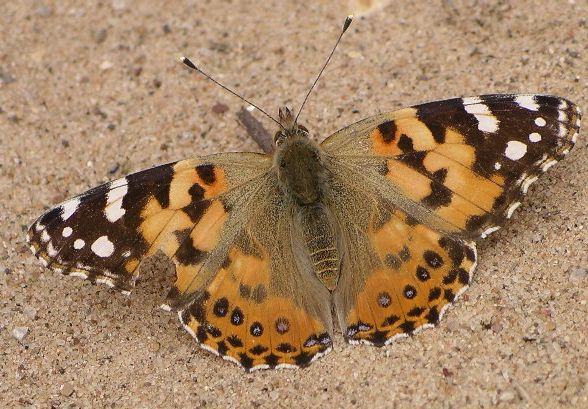
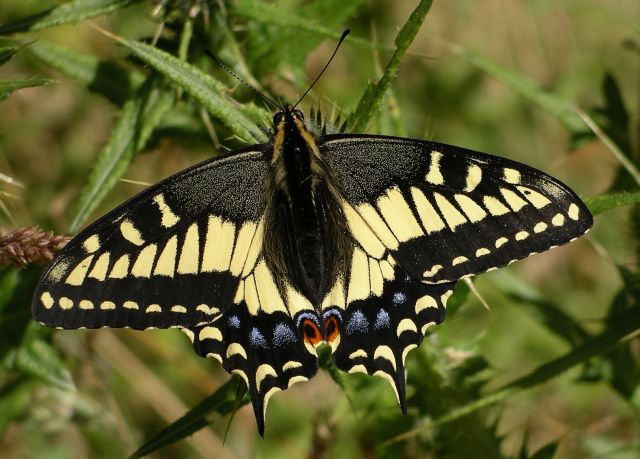
Butterflies exhibit a surprising range of behavior. Before I started studying these insects I assumed that their movements were rather random. As I began to observe them more closely, though, I realized that they behave much more purposefully than I had imagined. Granted, much of this behavior is "wired in" or inherited, but it is interesting to observe nevertheless. Consider examples of four categories of behavior:
Butterflies are cold blooded. They fly best at temperatures above 70oF. They will often bask in the sun in the morning or on a cloudy day to help get their temperature up. If the temperature gets too hot, they will reposition their wings to minimize exposure to the sun.

It was November at the bottom of the Grand Canyon and the day was hazy and cool. This Painted Lady spread its wings flat against the sand to soak up the sun's rays. As a rule, brightly colored butterflies bask with their wings open. If it gets too hot, they simply fold their wings.
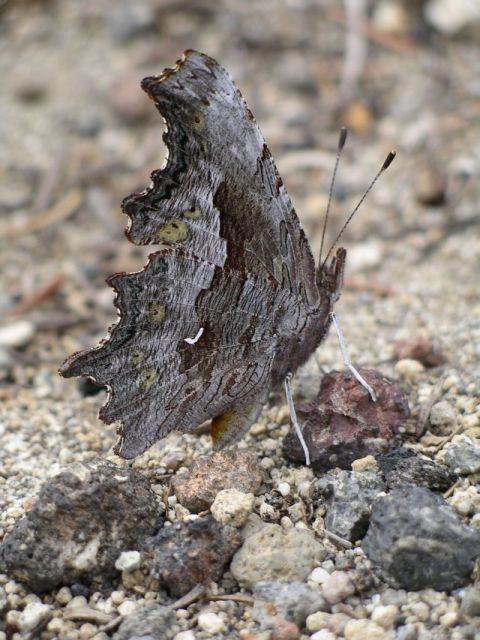 Hoary Comma (Polygonia gracilis)
Hoary Comma (Polygonia gracilis)
Other species, especially those with dark undersides, use lateral basking. Their wings are folded and they position their body so the under surface of the wings faces the sun. When the temperature gets too hot, they make a quarter turn so the wings are parallel with the sun's rays.
Although a female may lay a hundred eggs, only two typically grow to adulthood. There are many threats to to survival but butterflies have evolved to counter them. On this page we will concentrate on adaptations to elude vertabrate predators, especially birds. Birds are frequent predators on both the caterpillar and the adult butterfly. Without evolving various defenses, butterflies would have vanished long ago. Here are just a few of these strategies.
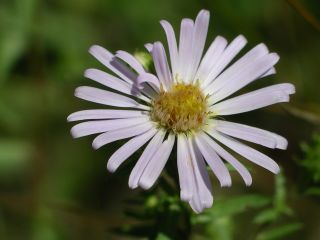
Yes, there is no butterfly on the flower in the picture on the right. That is the point. In the second that it took for my finger to press the shutter release and take the picture, my intended target was gone. Butterflies are great motion detectors and can be surprisingly fast fliers. They will inevitably fly if you or a predator approaches. Your slightest movement or even your shadow can trigger flight. The photographer's only hope to get a picture is to approach very slowly and steadily with no jerky movements.
 Western Sulphur
Western Sulphur
The key is their large compound eye. It is very sensitive to motion and color, though not very good at detecting patterns. They not only see the color spectrum we see but ultraviolet as well. If you move very slowly and smoothly you can approach. Any jerky motion and the butterfly will fly.
Most people think of butterflies as brightly colored, but that is probably because these are the ones they tend to notice. A number of butterflies use camouflage as an effective survival strategy. You might well have walked by a scene like the photo below and not thought much about it.
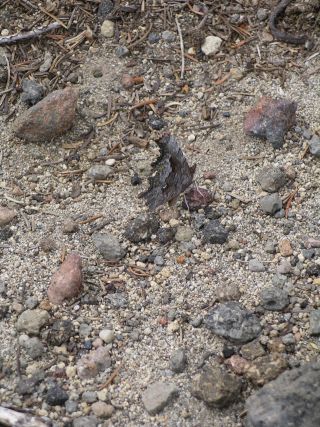
Unless you were looking for it you would have missed the basking Hoary Comma. The mottled gray and brown colors make it very difficult to see when resting on a tree trunk or rocky ground.

...at least until it opened its wings. The sudden spectacle is thought to have some value in startling predators.
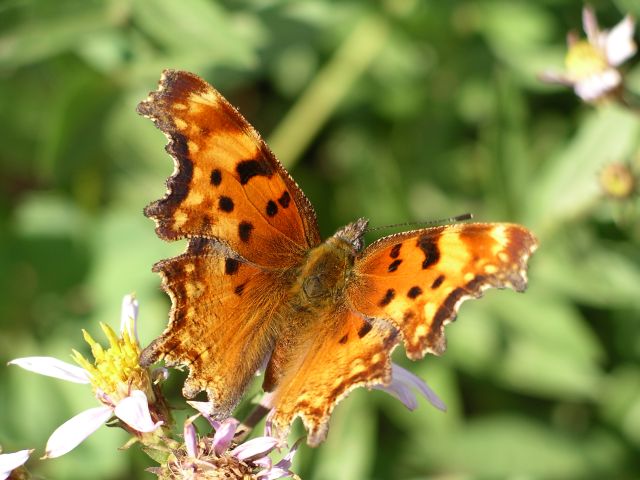 Hoary Comma (Polygonia gracilis)
Hoary Comma (Polygonia gracilis)
As a rule, brightly colored butterflies are either poisonous--or mimics of a poisonous butterfly--and advertise that fact. Butterflies that birds might find tasty are typically well camouflaged or just drab.
There is general agreement that many species developed spots to either frighten or distract would be predators. Some species, like this Wood Nymph sport a pair of so called eye spots that might appear to a predator like the eyes of a larger animal.
 Common Wood Nymph (Cercyonis pegala)
Common Wood Nymph (Cercyonis pegala)
Other species have bright spots near the tail that draw the predator's attention away from the head. If you look closely, you will see that many of these butterflies have chunks missing from their hind wing, suggesting that the ruse was successful. An attack to the head would likely be fatal, but with a chunk out of their wing they are still able to fly. Hairstreaks will often rub their hind wings back and forth, making these spots stand out even more.
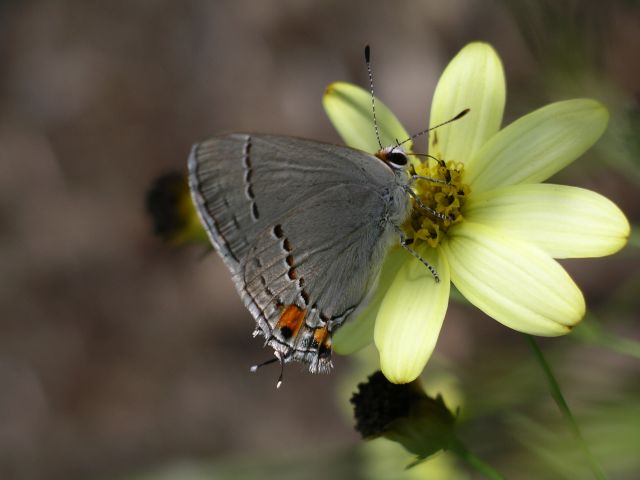 Gray Hairstreak (Strymon melinus)
Gray Hairstreak (Strymon melinus)
The Monarch catepillar feeds on milkweed. It stores the toxins in its tissue, making it poisonous to most predators. As a butterfly, it is brightly colored, advertising its identity. The Viceroy, an unrelated butterfly, has evolved to look very much like a Monarch, capitalizing on the fact that most predators have learned to avoid its poisonous look alike.
Most butterflies are short-lived and primarily lives off the fat accumulated in the caterpillar stage. However, nectaring or puddling are common behaviors that either extend their brief lives or supply valuable nutrients for mating pairs.
Butterflies have developed a long proboscis that can probe the flower for nectar. It is like a flexible straw that is kept coiled next to the body in flight but is extended to sip the sweet fluid when the butterfly finds a suitable flower head.
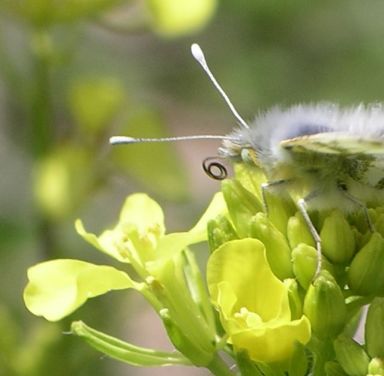

Here a Large Marble coils the proboscis as it seeks another flowerhead and uncoils it to begin sipping nectar.
Night flying moths lack such a mouth piece and do not nectar. However, some day flying moths do nectar.
A field of wildflowers is a good place to study butterflies, especially in the late afternoon. A nectaring butterfly is typically preoccupied with drinking and is less alert to your approach. As long as you move slowly you can often get very close to study or photograph the specimen. Note that most of the photographs on these pages were taken while the subject was nectaring.
As you might surmize, nectaring aids in the pollenation of some flowering plants. Bees have a much greater impact overall but butterflies do play a role.
Sometimes butterflies, especially males, will congregate at the edge of mud puddles or moist ground. They extend their proboscis to the surface and sip water which is rich in salts and minerals. These nutrients may help in the production of pheromones, the male's sexual attractant, or aid in reproduction in other ways.
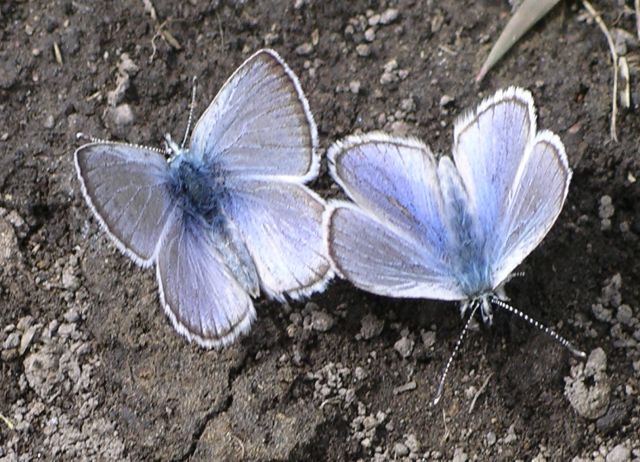 Boisduval's Blue (Plebeius icarioides)
Boisduval's Blue (Plebeius icarioides)
The main function of the adult butterfly is reproduction. Thus the process of finding a mate occupies much of their brief existance.
Males spend most of their time looking for potential mates in one of two ways: perching or patrolling. Some species like this Tailed Copper find a perch and wait for a candidate to fly by. They will often return to the same spot or a nearby perch after investigating an intruder.
 Tailed Copper (Lycaena arota)
Tailed Copper (Lycaena arota)
There is controversy over whether perching behavior involves protecting a territory. Males tend to chase anything that flys by, including birds or other insects, and then return to the same perch, much like a territorial bird. But experts point out that the butterfly only sees a fluttering motion and must give chase to get close enough to smell the pheremones that tell him whether the target is the correct species and sex.
Patrolling is hard to capture in a photo but easy to observe. The next time you see a big yellow Tiger Swallowtail, stop and watch it. If it is a patrolling male it will fly back and forth in a rough search pattern along the edge of the forest. Superfically its flight will appear somewhat random but if you keep watching you may be able to see that is making a circuit.
Hilltopping is a form of patrolling. Some species will congregate on ridges or hilltops.
Once a male finds a receptive female, the pair may go through a courtship dance depending on the species. Afterwards they position themselves back to back and the male clasps the female's abdomen and deposits sperm.
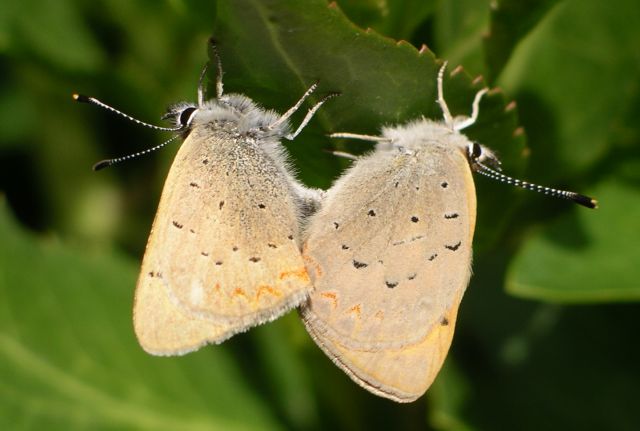 Purplish Copper (Lycaena helloides)
Purplish Copper (Lycaena helloides)
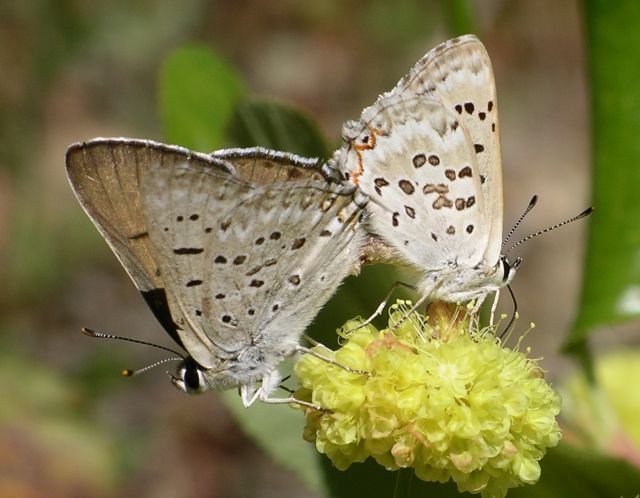 Edith's Copper
Edith's Copper
This is one time when butterflies are approachable. You can usually get very close to a mating pair and capture the moment on film.